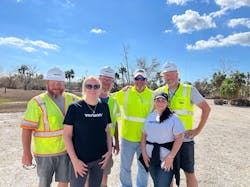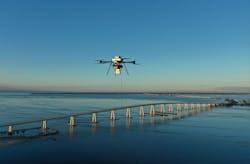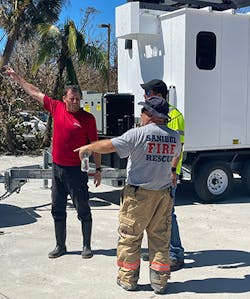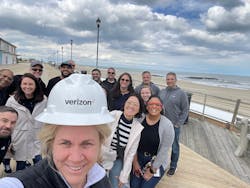Executive Insights with Julie Slattery, Senior Vice President, Core Engineering & Operations, Verizon
Leaders are guides. They set and achieve challenging goals. They take decisive action in less-than-ideal situations. They are students of their respective fields.
They allow themselves to be human and are authentic about walking a mile in their teams’ collective shoes.
But the truly effective leader is more. To borrow a great description of a leader from a leader, I like what John Quincy Adams said, “If your actions inspire others to dream more, learn more, do more and become more, you are a leader.”
With that, I invite you to learn from Julie.
Topic: 5G Network Evolution for First Responders
Verizon conducted a survey of nearly 2,000 first responders from across the nation and close to 80% identified 5G as a priority for their agency. First responders expect they will be using drones, augmented and virtual reality training applications and connected vehicles daily within the next five years, if not sooner. The daily use of drones is expected to rise by over 30% in the next four years alone.1
ISE: What is required by network engineering teams to meet the needs of our first responders?
Julie Slattery: Verizon’s network teams prepare 365 days a year to ensure our network is built for reliability and resiliency. This starts with how we engineer and design the network—including redundant paths and backup power.
Network engineering teams are tasked with hardening network assets all year, so when an emergency happens, we are prepared to support first responders on the ground and to keep customers connected when it matters the most. This requires operational discipline in activities like exercising our generators, pre-staging fuel deliveries, and deploying additional mobile assets to provide temporary service when necessary.
We also maintain a specialized group of Verizon network engineers called MERIT2—Major Emergency Response Incident Team—to be deployed when necessary to protect Verizon’s network assets and facilities during natural disasters or hazardous materials incidents.
Our Verizon Frontline Crisis Response Team provides on-demand, emergency assistance to government agencies, first responders, frontline workers, and communities—to help maintain mission-critical communications when they’re needed most. We have more than 200 certified drone pilots, and one-of-a-kind solutions developed with and for first responders (e.g. THOR3, MUTT4, THOR’s Hammer5). And Verizon Frontline delivers the most reliable 5G network for first responders in more cities today while continuing to help agencies build for the future.
Topic: Network Security
ISE: Share the network security approaches—like SASE (Secure Access Service Edge) or others—Verizon is adopting to help with this.
Slattery: Security is built into Verizon’s networks by design. We embed controls and services directly into our network such as DDoS Protections. Further, we have become one of the first Tier 1 telecom providers to be accepted as a participant of Mutually Agreed Norms for Routing Security (MANRS)6, which is a global initiative to help reduce the most common routing threats. We are also seeing an uptick in private 5G sales whereby we are replacing customer Wi-Fi solutions due to performance and better security. We also have a significant investment in Managed Security Services and Professional Security Services.
We work directly with our customers to risk assess their environments and develop solutions that meet their needs from our ThingSpace platform for IoT security, to SASE solution to support their Zero Trust Architecture goals and address more people working remotely. We also recently launched our Threat Protection services for our Fixed Wireless Access product.
Topic: Network Automation
ISE: What is Verizon doing to automate their networks to streamline network operations, reduce human errors, improve efficiency? Talk about your network automation successes and how it will impact field teams.
Slattery: Network reliability is the single most important thing we can offer to our customers. We are monitoring the network 24/7/365 and perform audits for overall health of the network to ensure our customers have a superior network experience and to fix any potential problems before they impact the customer. Alarms and big data telemetry provide self-healing and optimization across the network (RAN, transport, and core) using data intelligence to reset equipment or run commands to restore an outage. We’re also able to see configuration deviations from original install/activation time setup due to various triggers—such as change management activities performed by a dispatch technician—and we’re able to identify and restore those to original condition and avoid outages.
Verizon has a culture of accountability and awareness to minimize preventable incidents and human errors. We have ongoing learning and development campaigns that educate engineers on new technology and operational activities, ensuring they evaluate the impacts before any changes are deployed.
We also have great partnerships across the business with network teams, systems and process teams, and AI teams working together with common goals of driving efficiencies, automation and using predictive analytics to improve reliability. As we virtualize network functions it enables us to increase efficiency, productivity, and agility. Automation of network functions is a key part of the strategy to keep up with growing demands. This enables our field teams to keep pace with increased volumes and workloads, while driving increased efficiency as the network grows.
Topic: Network Restoration Successes
ISE: Talk about how network installation and restoration processes will change with robotics and when we can expect to see those changes.
Slattery: Robotics are being used today. They are an active part of our network installation and restoration efforts. It’s proven to be faster and safer, especially during moments when restoration efforts are needed. During natural disasters or emergencies, we’ve been able to leverage robotics for both mini cell tower service and to assess damage in hard to access locations. This makes for a faster recovery and shorter outages for our customers.
For example, last year we deployed drones during the recovery efforts after Hurricane Ian. When the bridge connecting Sanibel Island to the mainland collapsed and wireless service needed restoration, Verizon launched a tethered drone outfitted with a cellular node (a flying cell site) that provided cellular coverage from the air to support search and rescue teams and first responders on the ground. (See Figure 1.) The drone provided coverage for an approximate 5–7-mile radius and could fly for up to 1,000 hours. When first responders and customers are limited and unable to get access to critical information and help, the temporary coverage a drone provides can significantly help the situation.
Topic: AI
ISE: How is Verizon using AI across the network?
Slattery: We use AI for force models to predict growth and capacity needs to ensure that we have the right resources in the right places, we use AI for predictive analytics and insights into network trends so we can proactively address issues before they occur, and we use AI to understand customer insights so we can better respond to their needs.
Among some notable use cases, Verizon used our own AI platform7 to help build our 5G network.8 The AI models, designed by in-house data scientists, factor in multiple variables that can alter the strength of 5G signals, the position of the transmitter, as well as other nearby transmitters.
Recently, we announced we are also using artificial intelligence and machine learning to analyze over 10 million 811 dig requests annually to identify which requests pose the greatest risks for accidental fiber damage. A Machine Learning algorithm generates a score each day using the probability of a specific fiber cable at a specific location on that day being damaged due to construction/excavation activity. At any given day, there are 50-100K such locations in the US, and each of them is given a risk score (1-100). From there we can help deploy interventions to prevent accidental cuts for the projects deemed most high risk.
Topic: Network Upgrade and Customer Transparency
ISE: Verizon has been talking about their biggest network upgrade ever; can you expand on this and what it means for customers?
Slattery: Verizon is upgrading its network around the country to make sure our customers continue to have the excellent experience they've come to expect from Verizon. This has meant multi-year redesigns of our network architecture deploying the C-Band9 spectrum we acquired in 2021. Network upgrades include deploying new cell sites to extend coverage and capacity in local communities, adding more capacity on fiber optic cables to move more data through the network and adding bandwidth to the cellular network to accommodate new services like wireless Internet service for homes and businesses. In the spirit of transparency, we’re proactively notifying customers about upgrades in their area.
Topic: Personality Trait
ISE: What are some of the most important personality traits someone needs to succeed as a leader?
Slattery: For me, two traits that I value the most are listening and humility. I find these are often underrated. We cannot successfully lead teams by doing all the talking and telling them what to do. We need to listen, to understand how things are really working, to understand challenges, to hear ideas, to empower our teams and learn how we can best support them. The second trait I value most is humility. Leading is about building the strongest teams we can and achieving a greater good. The best leaders—to build the strongest teams—need to be confident enough to surround themselves with people who are better and stronger than them in many ways. They don’t need to be the smartest people in the room, and they don’t have huge egos. They bring people together, recognize and value strengths, and create an environment that enables each team member to utilize those strengths to their maximum potential to contribute to the team achieving their goals.
Topic: Leadership Style
ISE: Please share ONE leadership principle that encapsulates your leadership style.
Slattery: There is no one right way to lead. It's important to lead with authenticity—true to who you are, comfortable and confident in your approach, which may be different than others. If I had to pick one quote that is my guiding principle in leadership, it is “True leaders don’t create followers. They create more leaders".
I believe deeply and spend a lot of time developing and investing in leaders at every level with the goal of leaving an impact with stronger leaders for our business. I learn as much as I offer and so I develop myself through this process as well. I do this through offering and creating opportunities to stretch skill sets in new areas, through sponsoring, advocating and mentoring talent across the business, through helping others see their own strengths and new areas they can add value, through constructive feedback on areas of opportunity, and through sharing my own experiences—the good, the bad, and the ugly—in the hopes that others will connect and relate to those experiences.
Topic: Risks
ISE: What’s the biggest professional risk you’ve taken?
Slattery: My career has been built by taking a series of risks repeatedly. That is, to leave a role I was comfortable and performing well in to take on new assignments in new areas where I had to learn whole new spaces. I have lost count of the number of roles I have had over my 26 years at Verizon. Some moves were promotions, many were lateral moves. Each time I have changed roles I have done so deliberately to expand my knowledge of the business. Many times, this meant leaving teams where I knew I was highly rated and developing subject matter expertise to take on assignments in unknown territory. Over the years, this has provided me with a breadth of experience and relationships that continue to be extremely valuable to me. I always encourage employees to not stay in any one role too long. There is no right length of time, as I’m often asked, but you need to be aware if you are continuing to learn and grow. When you are ready to make a move, look to spaces that are a far enough leap to push your limits and broaden your exposure to different parts of the business.
Topic: Legacy Systems and Interoperability
ISE: Talk about the ongoing challenges broadband service providers (BSPs) face to make legacy systems interoperable with newer and more effective solutions. What can be done to help them with this?
Slattery: We are moving quickly to migrate and decommission legacy network assets to enable us to invest in growth areas, ultimately creating a better customer experience. Verizon has a strong strategy and vision that is focused on deploying the best networks and systems. Our engineers have a clear mission to build the network platforms, like the Intelligent Edge Network (IEN), using the directional systems that enable us to manage inventory, provisioning, and maintenance functions more efficiently and effectively. Automation and open APIs are key enablers to provide more effective end to end solutions as we evolve our network and customer experience.
Topic: Network Slicing
ISE: There has been a growing demand for network slicing. Talk about the network changes required for this.
Slattery: Different applications require different network resources. Verizon’s 5G standalone core cloud-native virtualized applications, in combination with built-in artificial intelligence (AI) and machine learning (ML), will enable the dynamic allocation of the appropriate resources, thereby creating network slices. It will also allow for automated network configuration changes, including the ability to scale up or scale down network function capacity—to provide the right service levels and network resources needed for each use case.
The advanced capabilities, high speed, increased capacity, and low latency of 5G is inspiring development of a wide variety of new use cases that include everything from massive numbers of IoT devices that use very few network resources, to smartphones with nearly infinite opportunities to use data, to more complex solutions such as gaming, AR/VR and mixed reality that will require massive computing capabilities and low latency on the edge of the network. Those solutions will each require different combinations of network capabilities.
Topic: Paying It Forward
ISE: Throughout your 25+ years in engineering, operations, and customer service, what leadership principles can you recommend to other leaders who want to follow your path?
Slattery: When I lead an organization, I try to facilitate a dynamic across my leadership team that we win together, or we lose together. We align around common goals for the business—and each leader contributes differently to those goals—but no one team succeeds if the larger organization does not meet its goals. We show up together, as a leadership team. I want to create an environment where team members are helping each other, sharing ideas, and lifting each other up.
Ultimately, regardless of what role I am in, the goal in leadership is to create an environment where every team member can perform and contribute to their maximum potential. This means creating a safe and inclusive culture, where every team member feels valued and respected. The goal is a safe environment, built on a foundation of trust, where we can challenge each other, share different opinions, and arrive at the best business decisions. Diversity is a huge part of driving the best outcomes. We need different ideas from team members with different experiences and different perspectives to ensure we are considering all angles and arriving at the best conclusions.
I believe as leaders, we are here to serve the teams we lead. We give guidance on high level goals, but the best ideas on “how” often come from our frontline employees. We need to create an environment where employees feel safe speaking truth to power and sharing opinions, so we know where the real problems are and we get the best ideas on how to address them. We need to engage, listen, empower, and support them in being successful to achieve goals.
REFERENCES AND NOTES
1. Tech Supporting Those Who Save Lives in 2023, https://www.verizon.com/about/news/tech-supporting-those-who-save-lives-2023
2. MERIT, https://www.verizon.com/about/news/verizon-merit-team-completes-annual-hazardous-materials-recertification
3. THOR, https://www.verizon.com/about/news/verizon-frontline-unveils-thor
4. MUTT, https://www.youtube.com/watch?v=yr66fHedA04
5. THOR’s Hammer, https://www.verizon.com/about/news/verizon-frontline-debuts-thors-hammer
6. MANRS, https://www.manrs.org/
7. AI Platform, https://www.cio.com/article/405371/verizon-wireless-ai-platform-paves-way-for-5g-build-out.html
8. 5G Network, https://www.wsj.com/articles/verizon-enlists-ai-in-5g-network-build-out-11628103712
9. C-Band, https://www.verizon.com/about/news/verizon-announces-c-band-auction-results
ABOUT JULIE SLATTERY
Julie Slattery is SVP of Verizon’s Core Engineering & Operations team. In this role, she leads a team of nearly 7,000 network engineers and technicians who build and operate the most reliable, highest performing and secure networks for Verizon’s customers, including deployment of the 5G core. Her team is also responsible for Verizon’s business continuity program, ensuring that Verizon can serve customers and keep them connected when it matters most. Throughout her tenure at Verizon, Julie has held a variety of leadership positions of increasing responsibility across engineering, operations, and customer experience. She has led large, global organizations serving Verizon’s wholesale, multinational enterprise, and consumer customers. She holds a master’s degree in technology management from Stevens Institute of Technology and a bachelor’s degree from Wake Forest University.
Follow Julie on LinkedIn. For more on Verizon, visit www.verizon.com. Follow them on Twitter @Verizon, LinkedIn, and Facebook.
About the Author
Sharon Vollman
Content Ambassador for ISE EXPO
Sharon Vollman is the Content Ambassador for ISE EXPO. She is passionate about collaborating with thought leaders, SMEs and hard-working doers who design, plan and deploy ultra-reliable broadband networks. Vollman is committed to creating a variety of educational offerings for ISE EXPO attendees that inspire them to connect every U.S. citizen with the broadband networks we all want for our children and grandchildren.
Vollman has created educational partnerships with Broadband Service Providers including AT&T, Verizon, Lumen, Frontier Communications and others. She has covered the telecom industry since 1996.






